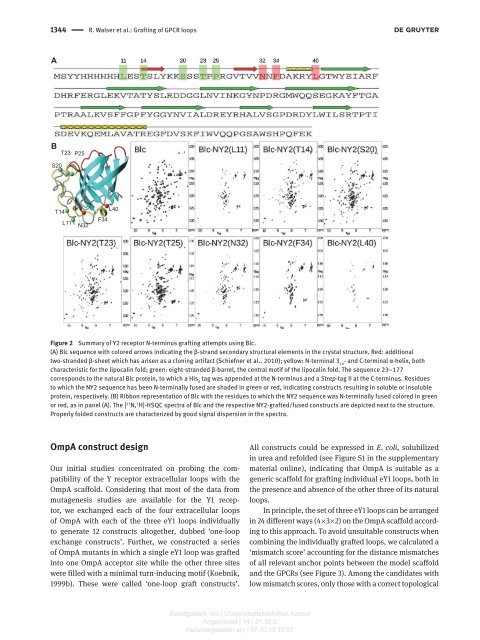β -Barrel scaffolds for the grafting of extracellular loops ... - KOBRA
β -Barrel scaffolds for the grafting of extracellular loops ... - KOBRA
β -Barrel scaffolds for the grafting of extracellular loops ... - KOBRA
You also want an ePaper? Increase the reach of your titles
YUMPU automatically turns print PDFs into web optimized ePapers that Google loves.
1344 R. Walser et al.: Grafting <strong>of</strong> GPCR <strong>loops</strong><br />
A<br />
B<br />
T23<br />
P25<br />
S20<br />
T14<br />
L40<br />
F34<br />
L11 N32<br />
Figure 2 Summary <strong>of</strong> Y2 receptor N-terminus <strong>grafting</strong> attempts using Blc.<br />
(A) Blc sequence with colored arrows indicating <strong>the</strong> <strong>β</strong> -strand secondary structural elements in <strong>the</strong> crystal structure. Red: additional<br />
two-stranded <strong>β</strong> -sheet which has arisen as a cloning artifact (Schiefner et al. , 2010 ); yellow: N-terminal 3 10<br />
- and C-terminal α -helix, both<br />
characteristic <strong>for</strong> <strong>the</strong> lipocalin fold; green: eight-stranded <strong>β</strong> -barrel, <strong>the</strong> central motif <strong>of</strong> <strong>the</strong> lipocalin fold. The sequence 23 – 177<br />
corresponds to <strong>the</strong> natural Blc protein, to which a His 6<br />
tag was appended at <strong>the</strong> N-terminus and a Strep -tag II at <strong>the</strong> C-terminus. Residues<br />
to which <strong>the</strong> NY2 sequence has been N-terminally fused are shaded in green or red, indicating constructs resulting in soluble or insoluble<br />
protein, respectively. (B) Ribbon representation <strong>of</strong> Blc with <strong>the</strong> residues to which <strong>the</strong> NY2 sequence was N-terminally fused colored in green<br />
or red, as in panel (A). The [ 15 N, 1 H]-HSQC spectra <strong>of</strong> Blc and <strong>the</strong> respective NY2-grafted/fused constructs are depicted next to <strong>the</strong> structure.<br />
Properly folded constructs are characterized by good signal dispersion in <strong>the</strong> spectra.<br />
OmpA construct design<br />
Our initial studies concentrated on probing <strong>the</strong> compatibility<br />
<strong>of</strong> <strong>the</strong> Y receptor <strong>extracellular</strong> <strong>loops</strong> with <strong>the</strong><br />
OmpA scaffold. Considering that most <strong>of</strong> <strong>the</strong> data from<br />
mutagenesis studies are available <strong>for</strong> <strong>the</strong> Y1 receptor,<br />
we exchanged each <strong>of</strong> <strong>the</strong> four <strong>extracellular</strong> <strong>loops</strong><br />
<strong>of</strong> OmpA with each <strong>of</strong> <strong>the</strong> three eY1 <strong>loops</strong> individually<br />
to generate 12 constructs altoge<strong>the</strong>r, dubbed ‘ one-loop<br />
exchange constructs ’ . Fur<strong>the</strong>r, we constructed a series<br />
<strong>of</strong> OmpA mutants in which a single eY1 loop was grafted<br />
into one OmpA acceptor site while <strong>the</strong> o<strong>the</strong>r three sites<br />
were filled with a minimal turn-inducing motif (Koebnik ,<br />
1999b ). These were called ‘ one-loop graft constructs ’ .<br />
All constructs could be expressed in E. coli , solubilized<br />
in urea and refolded (see Figure S1 in <strong>the</strong> supplementary<br />
material online), indicating that OmpA is suitable as a<br />
generic scaffold <strong>for</strong> <strong>grafting</strong> individual eY1 <strong>loops</strong>, both in<br />
<strong>the</strong> presence and absence <strong>of</strong> <strong>the</strong> o<strong>the</strong>r three <strong>of</strong> its natural<br />
<strong>loops</strong>.<br />
In principle, <strong>the</strong> set <strong>of</strong> three eY1 <strong>loops</strong> can be arranged<br />
in 24 different ways (4 × 3 × 2) on <strong>the</strong> OmpA scaffold according<br />
to this approach. To avoid unsuitable constructs when<br />
combining <strong>the</strong> individually grafted <strong>loops</strong>, we calculated a<br />
‘ mismatch score ’ accounting <strong>for</strong> <strong>the</strong> distance mismatches<br />
<strong>of</strong> all relevant anchor points between <strong>the</strong> model scaffold<br />
and <strong>the</strong> GPCRs (see Figure 3 ). Among <strong>the</strong> candidates with<br />
low mismatch scores, only those with a correct topological<br />
Bereitgestellt von | Universitaetsbiblio<strong>the</strong>k Kassel<br />
Angemeldet | 141.51.38.5<br />
Heruntergeladen am | 07.10.13 13:53















